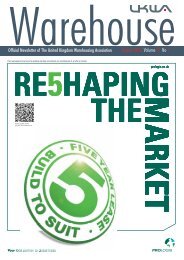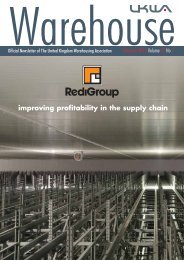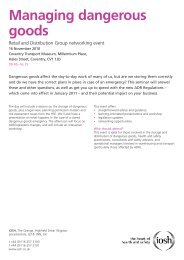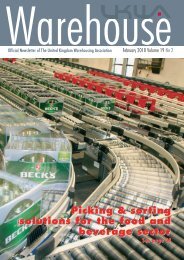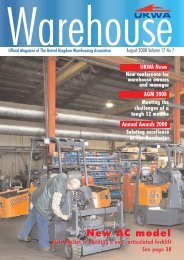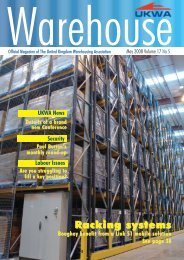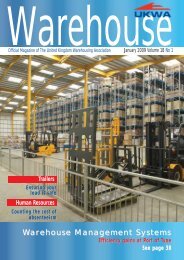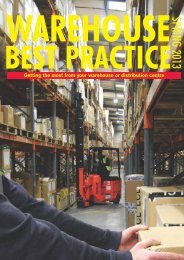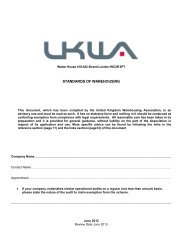Warehouse - United Kingdom Warehousing Association
Warehouse - United Kingdom Warehousing Association
Warehouse - United Kingdom Warehousing Association
You also want an ePaper? Increase the reach of your titles
YUMPU automatically turns print PDFs into web optimized ePapers that Google loves.
Advertorial 11AmcoInternational’s RDC<strong>Warehouse</strong> Management System Summary Case StudyObjectivesDue to a move into the bulk supermarket suppliesand the subsequent increase in workload it was identifiedthat existing logistics staff would be unable to meetthe new levels of demand.In order to minimise any additional staff recruitmentit was proposed to investigate the use of a <strong>Warehouse</strong>Management System (WMS) to automate processesacross the three 22,000 pallet warehouses that madeup the RDC.It was agreed that in identifying a suitable WMS thefollowing points should be considered:1. The solution should utilise a barcodedapproach to maximise productivity andminimise data entry errors.2. Easier storage planning and full compliance toFIFO criteria.3. Easy location and full visibility of stock.4. Show significant reduction in stock losses.5. Where possible provide a paper free solution.6. Offer an integrated solution where stock acrossthe multiple warehouses could be viewedcentrally in a single location.7. A full audit trail should be maintained.8. Vehicle handling times should be reduced.9. The system should attract a minimal capitaloutlay.Approach and RecommendationsA number of candidate systems were considered andseveral were invited to demonstrate at the RDC.The quality of the systems and ease of use variedgreatly, but a shortlist was drawn up and seconddemonstrations were arranged.In terms of functionality, ease of use and cost, onesystem was a clear winner ‘Think <strong>Warehouse</strong>’ developedby Think IT Systems Limited.While cost was not the only criteria, there are a coupleof relevant points in this area that require specialmention.It very soon became clear that the major costsinvolved could, in essence, be split into two main areas,these being the wireless infrastructure and the WMSitself.The wireless infrastructure presented a problem asthe free standing warehouses had various obstaclesbetween the buildings which stopped the continuity ofradio signal transmissions.This meant to meet the criteria of a single, globallyvisible solution would have required a significant investment(circa £40k-£50k) just to link the buildings together.Amco International’s chosen partner (Think ITSystems) were the only candidates to offer a no costsolution to the communication issue with their unique3G option. This 3G option allows their WMS to operateover the mobile phone network thus completely eliminatingthe need for a Wi-Fi network.The second major capital cost, the WMS itself, wasalso greatly minimised by adopting a rental programwith the supplier.Conclusion and Additional Benefits‘Think <strong>Warehouse</strong>’ has met all of the original criteriaand has in fact provided many benefits that werenot in the original requirements.Efficiency improvements have been so dramatic thatthe RDC has been able to expand from three warehousesto ten without any increase in staff numbers.The portability of the chosen system over the 3Gmobile phone network has considerably reduced buildingcosts when expanding. This allowed more remote(and lower cost) warehouses to be considered as therewas no longer a need to maintain a ‘line of sight’between the buildings for traditional Wi-Fi.Training was very easy with the average training timefor shop floor operatives being just 20 minutes, thusminimising down time.Due to the speed of the system, stock audits can nowbe successfully completed on a rolling one month basis.This is providing audited management information thatshows stock accuracy is now running at 99.8%.As the server and data are operated on a remotelyhosted server there is now the ability to work on thesystem on a laptop from anywhere there is an Internetconnection. In addition, a full multi-location back upregime is now in place providing an almost immediatedisaster recovery solution.Vehicle handling times (loading and unloading) havedropped dramatically. It now takes approximately 8% ofthe time it used to do to turn each vehicle around. Thishas allowed a much more structured approach to dockmanagement to be implemented.Automated pick generation from electronic sourcessuch as spread sheets and the Internet has reducedback office workload and has virtually eliminated dataentry errors.In summary, this exercise was unusual in that it wasnot originally driven by identifying cost savings.However, costing out the benefits to the business inincreased capacity and direct savings in non-salaryareas, it was estimated that the system produced areturn on investment within six months of going live.www.ukwa.org.uk May 2013





